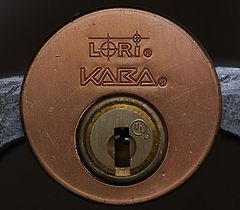KABA Gemini: Difference between revisions
No edit summary |
m (→KABA Gemini: fix order of lock_design) |
||
| (5 intermediate revisions by 5 users not shown) | |||
| Line 6: | Line 6: | ||
| maker = [[KABA]] | | maker = [[KABA]] | ||
| lock_type = [[Cylinder]] | | lock_type = [[Cylinder]] | ||
| lock_design = [[ | | lock_design = [[Pin-tumbler]], [[Dimple]] | ||
}} | }} | ||
| Line 54: | Line 54: | ||
'''Notes''' | '''Notes''' | ||
* The design of the Gemini pins and cylinder prevent [[Bumping|key bumping]] attacks.<ref>Fey, Han & Wels, Barry. What the Hack (2005). [http://wiki.whatthehack.org/images/0/00/BumpkeyPresentatie.pdf Bump Proof Locks]</ref> | * The design of the Gemini pins and cylinder prevent [[Bumping|key bumping]] attacks.<ref>Fey, Han & Wels, Barry. What the Hack (2005). [http://web.archive.org/web/20110322070351/http://wiki.whatthehack.org/images/0/00/BumpkeyPresentatie.pdf Bump Proof Locks]</ref> | ||
== Gallery == | == Gallery == | ||
| Line 74: | Line 74: | ||
[[Category:Pin-tumbler locks]] | [[Category:Pin-tumbler locks]] | ||
[[Category:Dimple locks]] | [[Category:Dimple locks]] | ||
[[Category:KABA]] | [[Category:KABA|Gemini]] | ||
[[Category:UL 437 locks]] | [[Category:UL 437 locks]] | ||
[[Category:Lock models]] | |||
Latest revision as of 14:13, 24 December 2022
KABA Gemini
| KABA Gemini | |
 | |
| Name | KABA Gemini |
|---|---|
| Manufacturer | KABA |
| Lock Type | Cylinder |
| Lock Design | Pin-tumbler, Dimple |
The KABA Gemini is a UL 437 rated dimple lock designed by KABA and manufactured by the Lori Corporation of Connecticut, USA. The Gemini uses three rows of dimple pins oriented at 4, 8, and 12 o'clock in the plug. The Gemini is one of the few pure pin-tumbler locks that is protected against key bumping by design.
The Sargent KESO lock is functionally equivalent to the Gemini.
Principles of operation
The Gemini functions like a standard dimple lock, but it has three sets of active pin-tumblers. The key is bitted on the sides and edges of the blade and is reversible. The lock itself is a combination of cylinder and inner core, with a core retaining screw at 1 o'clock.
Bottom pins are lightly spooled to deter lockpicking, and mushroom bottom pins are available. Factory standards dictate 2-4 mushroom pins be used in each cylinder. The 4 and 8 o'clock pin chambers in the lock (and cuts on the key) are slanted upward at a 15 degree angle. This helps prevent against key bumping and unauthorized duplication. There are 6 six chambers in the 8 o'clock position and 5 in the 4 o'clock position. Both have four pin depths available for bottom (key) pins. There are three depths and 10 positions available for pins in the 12 o'clock chambers, but the first position (nearest the bow) is not used. Positions 3, 5, 7, and 9 are used in traditional systems, and 2, 4, 6, 8, and 10 in master key systems.[1] In all chambers, balanced top (driver) pins are used to prevent decoding and the use of comb picks.
The Gemini also uses a variety of components to resist forced entry. Hardened steel rods are placed in the plug at 3, 9, and 12 o'clock, and in the cylinder at 12 o'clock. The core retaining screw itself acts as a defense against various attacks.
Notes
- Pin chambers are spaced so that rotation does not allow top pins to fall into the other chambers. However, rotation of the plug without a key inserted allows the pin-tumblers to fall into the keyway.
- Pins are nickel plated via electrolysis to prevent corrosion.
Disassembly instructions
The Gemini is complicated to disassemble because of the several layers between the cylinder and the plug. In addition, the design of the Gemini does not allow a plug follower to be used until the core is removed from the cylinder.
- Remove the cam or C-clip.
- Remove the core retaining screw from the cylinder at 1 o'clock.
- Extract the core
- Remove the core's cam/extension piece (if any)
- Slide the core cover off, be careful to not let any springs or pins fall out. Alternatively, use a small diameter plug follower.
Notes
- In key-in-knob (KIK) cylinders, the bible is screwed into the core. This must be removed before step 5.
- If a plug follower is used in step 6, remember that pin stacks are balanced; complete disassembly may be required.
Vulnerabilities
The Gemini may be vulnerable to the following:
Notes
- The design of the Gemini pins and cylinder prevent key bumping attacks.[2]
Gallery
References
- ↑ Phillips, Bill. Locksmithing. 1999.
- ↑ Fey, Han & Wels, Barry. What the Hack (2005). Bump Proof Locks




